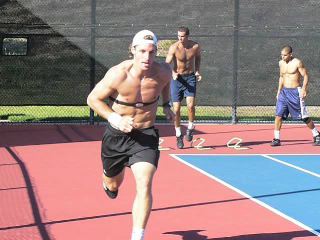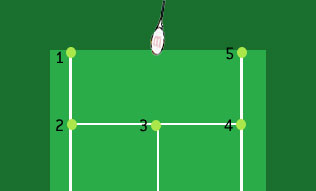In tennis footwork training, players practice specific drills and exercises which often involve full court sprints and other speed drills to simulate effective movement during an actual point.
While tennis footwork training is neither fun nor easy, every elite tennis player practices these drills to improve their tennis footwork. In order to be a great tennis player, tennis footwork drills must be incorporated into training on a regular basis.
Understanding the Need for Tennis Footwork Training
Tennis players all realize that proper stroke mechanics are essential to developing a winning game. But just as important is the need to develop proper footwork and movement.
Some players, especially the young ones feel as if they can just rely on their natural athletic ability and run down every ball without necessarily having to train themselves how to properly move their feet.
Even at the professional level, this way of thinking has been seen. A good example is five-time Wimbledon ladies’ singles champion Venus Williams. As a teenager, Venus came on tour looking like no other player before her. She was more than six feet tall but was slim, long-limbed and blessed with all kinds of natural athletic ability.
How Venus Williams Realized the Need for Tennis Footwork Training
Venus Williams had great power and could run down any ball using her long strides and her long reach. However, she lost frequently. Although she was fast, she didn’t move her feet properly. She frequently arrived at the ball unbalanced and uncoordinated. Players exploited this and made her look untalented.
Quickly realizing this, she worked very hard on her footwork and began to climb up in the rankings. Through proper tennis footwork training, she began to use her natural speed positively. Today, when you think about great movers in the sport of tennis, Venus’ name is always right there.


Elements of Great Tennis Footwork
Great footwork is quiet and efficient. It is also explosive and smooth at the same time. When you see a player with noisy feet, chances are, that player is moving inefficiently and must be made to run as much as possible.

World class tennis footwork is defined by efficient, quick and explosive movement around the court
Many players use running as their main method of tennis footwork training. This is a good exercise for developing endurance but it does not address the other needs of a tennis player. It does not train a player properly for the unique movements used on the court during points. These specific moves are the lateral shuffling steps, forward sprints, diagonal sprints and backward shuffles.
Specific Tennis Footwork Training
Additionally, players must learn to do a well-timed split step as well as a slide when playing on a clay court.
Tennis Footwork Training #1: Sprints


Sprints are a basic component of tennis footwork training. One particular set of sprints is used for tennis footwork training and is described as such:
- A starting point and a finish line approximately 30 meters away is designated. The player sprints to the finish line and then jogs back. He repeats the drill without resting.
- The third and fourth sprints are side shuffling runs to the finish line. If the third sprint was to the left, then the fourth sprint is to the right. Every sprint in this drill is followed by a jog back to the start line with no rest.
- The fifth sprint is a backward run to the finish line.
- The sixth sprint is another forward sprint.
- The seventh and eighth are lateral sprints just like the third and fourth but this time using cross over steps.
- The ninth is backward again.
- The tenth and last sprint is forward.For beginners, the sprints in the aforementioned drill should be done at ¾ pace. Once the player is in better shape, he or she should run each sprint at full pace.
Tennis Footwork Training #2 : Shuttle Runs
Shuttle runs are also frequently used for tennis footwork training. A typical example is to have the player sprint from baseline to service line and back, from baseline to net and back, from baseline to opposite service line and back, and finally from baseline to opposite baseline and back. Drills like this improve endurance and speed as well as footwork.
Tennis Footwork Training #3: Jump Rope
The jump rope is one of the best tennis footwork exercises. Actually, it is useful for almost all sports that require a lot of running and changing directions like boxing, football and basketball. Jumping rope enables the player to become accustomed to staying on the balls of his or her feet. It is also a great cardiovascular exercise, thereby improving endurance.


Every accomplished tennis player uses jump rope exercises in tennis footwork training
Tennis Footwork Training #4: Strength Training
Tennis footwork training also involves a fair bit of strength training. The muscles to develop are the quadriceps, hamstrings and calves. The following exercises are recommended for developing these leg muscles in order to improve footwork.


Using the stationary bike is important in improving overall endurance and a part of tennis footwork training
- Cycling– you can do outdoor cycling as part of your cross training or you can use a stationary bike in the gym. You should paddle at a fairly fast pace. Do this for about 30 minutes.
- Squats,split squats or leg lunges
- Stair climbing– you can do stadium sprints where you run up the stairs and down for a few sets. Alternatively, you can stay on a stair climbing machine at the gym for about 20 minutes. Using the stairs instead of the elevator or the escalator is also a great way to keep your legs in shape even in your daily life.
- Tip toe exercises– in this exercise, you stand with your feet flat and simply rise up to a tip toe position which you hold for about 3 seconds. Repeat this about 10-15 times. You don’t have to do consecutive sets but you can do this several times a day.
Tennis Footwork Training #5: Endurance Running
Distance running is useful for developing endurance but should be limited to about 2 miles and only done twice a week.
Tennis footwork training also includes specific drills designed to improve on court movement during practice hitting sessions. For example, instead of merely rallying back and forth, a player may be fed a ball which he or she must run down and hit. Ball after ball is fed and every shot has to be made on the run.
Improving On Court Movement with Tennis Footwork Training
Most importantly, the player has to shuffle back to the centre of the baseline after each and every hit. Other drills make use of shadow swings instead of actual hits. In one drill, the player has to run from the centre of the court to one corner of the baseline, make a shadow swing and then recover quickly back to the centre of the baseline.
This procedure is repeated for both forehand and backhand sides. There are also drills that do not require any swinging whatsoever. The direction drill is a drill where the player simply has to move in all sorts of directions: forward, backward, to the left, to the right, and all kinds of diagonal movements.
Tennis Footwork Training #5: Spider Drill
Some also call this the spider drill. The player starts at the centre T of the service line and returns to this point after every move. The first move is to one side line, and then the other side line, then forward to the net and back to the baseline. The fifth to eighth moves are diagonal moves to the left and right net post and to the left and right corners of the baseline.


The tennis spider drill is a popular exercise used in tennis footwork training
When designing a tennis footwork training program, make sure that the exercises are not done all on the same day. Allow your feet to rest a little or get used in a different way. For example, if you plan to do sprints or shuttle runs on a Monday, you should do distance running on Tuesday.
On Wednesday, you can focus on working out in the gym before doing sprints again the following day.
Developing Proper Tennis Footwork
When a players train to have proper footwork, their feet begin to move naturally and efficiently, allowing them to arrive at balls in proper balance. They will be better at timing their strokes well, hence making better shots.
When footwork becomes a subconscious thing, the player can focus more on what he or she needs to do on the court like the specific strategies and tactics to use against a particular opponent. The ability to get to every ball and set up in the right way to execute shots also increases a player’s confidence level.
Proper footwork not only improves a player’s defensive and retrieving ability but also how he or she attacks short balls leading to a better offensive game as well. In summary, footwork is really one of the keys to playing great tennis and must be worked on just as much as any other aspect of the game.
Learn to Hit a Forehand Like Roger Federer
If you want to jumpstart your forehand and play like the PROS, check out my 70+ page Tennis Ebook that will immediately show you how you can take your forehand to the next level.
The Modern Forehand Domination Ebook is guaranteed to improve your tennis technique, and increase power, topspin and accuracy of your tennis forehand!
Modern Tennis Forehand Ebook
Learn How to Hit a Forehand Like Federer, Nadal and Djokovic

